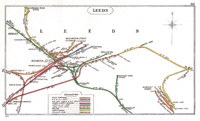LNER Restaurant Restaurant Triplet Sets
New additions placed here temporarily:
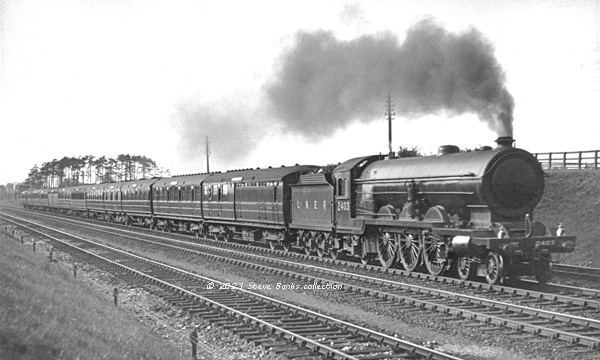
Raven Pacific, LNER A2 No 2403 City of Durham was captured on 25th May 1929 by William Rogerson at Eryholme with the Up 1.52pm Edinburgh-King's Cross. This was a heavy and much photographed train and has been granted one of the newer 1928 RTS sets. It became the 2.5pm that was to be fitted for wireless reception. Photo: Photomatic 6012.
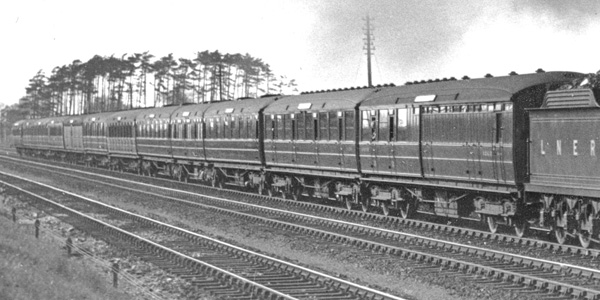
Basically, this was a formation from Edinburgh which carried portions from further north, including the famous Aberdeen-Penzance carriage, which can be seen on the far end of the train:
Edinburgh - BTK, FK, RTS, TK,TK, BG Perth - CK locker Aberdeen - TK, CK locker and BCK for Penzance.
The Aberdeen-Penzance carriage was detached at York and its position taken by a BCK from Glasgow. King's Cross was not reached until 10.5pm which meant a journey from Edinburgh of eight and a quarter hours and, from Aberdeen, twelve and a quarter hours. The journey from Aberdeen-Penzance ran through the night, eventually arriving at 7.40am the following day.
Click on the image for an enlargement
LNER Restaurant Restaurant Triplet Sets
This was another significant development from Gresley with a kitchen car articulated between dining cars: FO-RK-TO.
In his final book, Michael Harris gave quite a few pages to the the history of the 1924/28 sets and showed most of the Diagrams. Clive and I covered their deployment in the book under The Expresses/The Catering Core, and under Final Developments (BR), but space was too limited so here are some more pictures, divided into:
1 - 1924 design and 1928 upgraded design 2 - 1935 Silver Jubilee and later use in BR days 3 - 1938 Flying Scotsman and later use in BR days.
Overview
The total built in 1924-28 was eight (nine if you include the Leeds Quintuple set already in service) and no more sets were required until the mid- and late-1930s when perceptions were changing. Availability of catering coaches was always hard to maintain because of their complexity and there were sufficient RTS from the 1920s that two sets could be held as spares. When the "Silver Jubilee" started running in 1935 it was a single formation between Newcastle-King's Cross with its own RTS and a concentrated maintenance effort was needed to ensure availability. The problem was addressed two years later when the "Coronation" and "West Riding Limited" followed in 1937 and not only were twins used but a complete train was built as a spare which could stand in for any of the streamline trains.
The last triplet sets were built in 1938 exclusively for the "Flying Scotsman" when a pair of all-new trains was built for it. When failure required a substitute, or when the train was taken out for spring cleaning, older triplet sets stood in (see topic "The Flying Scotsman".
All told, the LNER ended up operating 11 triplet sets (twelve if you include the Leeds Quintuple Set) and while they didn't dominate services on the ECML and GNML as a whole, they certainly dominated the crack expresses and the flyers. For modellers there is plastic kit of a 1928 RTS in the Ian Kirk range, and etched brass body etchings for the 1938 set from RDEB. As time passed they moved around and the following pictures shows developments as far as possible in chronological order.
In BR days, after the Thompson free-standing 3-car sets came into use (FO, RK, TO) - and some BRk.1s - the Gresley triplets slipped down a notch but continued serving in important expresses on the ECML and GNML; none was cascaded to other Areas/Sections. Before long the ER was operating trains made up with mixtures of Gresley, Thompson and BR Mk.1 carriages and a teak-panelled RTS could comprise the oldest carriages in the formation. Such trains formed a high proportion of expresses on these main lines and we described examples in the book; here are some more illustrations with, for modellers, plenty of room for manoeuvre.
1 - The 1924 and 1928 designs
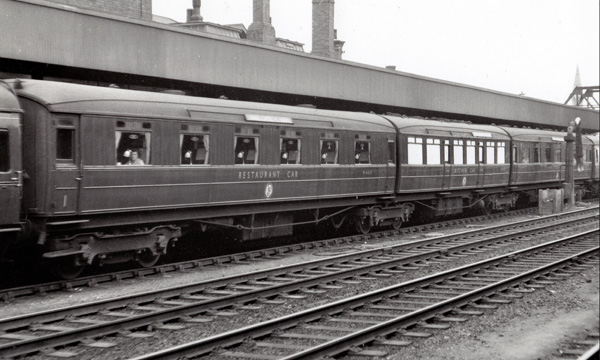
Pictures of restaurant triplets are rare and this one dates from May 1959, in a King's Cross-Leeds express at Doncaster. It's a first generation 1924 set, Nos E1401-3E, in BR maroon livery.
A distinguishing feature of the original design was the recessed end vestibules at the outer ends, along with the raised grab handle on the left hand side. Both show well in this view. Photo: R.S. Carpenter
Click on the image for an enlargement
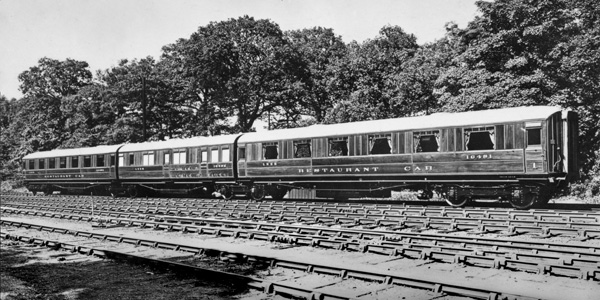
And for immediate comparison, a 1928 set with its flush sides. Actually, this is set Nos 16481-3 which was one of the two built for the "Flying Scostman" (note the absence of table lamps). Photo: Author's collection.
Click on the image for an enlargement
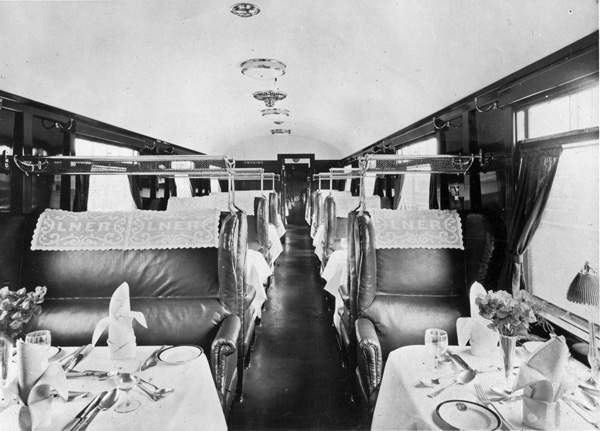
Now for two pictures of the interiors, beginning a 1924 RTS and the 1st class dining car - with conventional seats, albeit upholstered with leather, and just visible on the right, one of the table lamps. Photo: Author's collection.
Click on the image for an enlargement
When more sets were built in 1928, two were specifically for the "Flying Scotsman" and were given a grandiose Louis XIV style designed by Allom in which, among other things internally, the table lamps were replaced by pelmet lights and in the 1st class dining car, the seats were loose chairs. The latter was to be copied by BR in some of its restaurant cars.
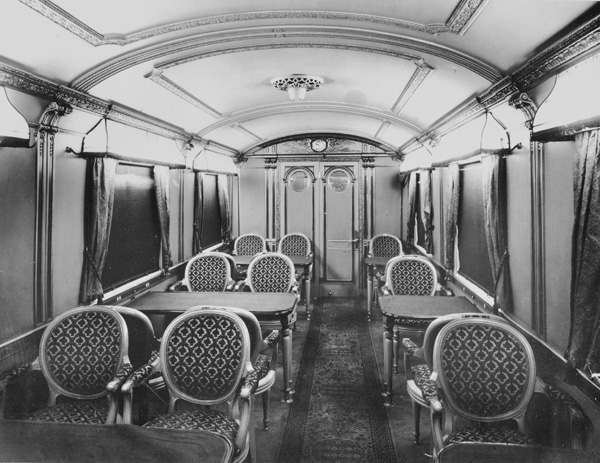
A portrait of the interior of the 1st class dining car in one of the 1928 Allom-design triplet sets for the "Flying Scotsman". The hands on the clock show approximately 10 o'clock and the blinds have been pulled down over the windows to keep out the daylight so that the interior and its lighting can be seen in a formal way.
It's also unusual because the tables haven't been covered or places set, the purpose being to show the free-standing chairs and other design features. Note, for example, absence of table lamps and pelmet lighting reflecting off the white ceiling and bathing the whole interior with indirect light. There are no suspended lights and the fancily decorated feature is an extractor vent.
In practice the loose chairs were unstable on sharp curves and were replaced by conventional "bench" seats. Photo: Author's collection.
Click on the image for an enlargement
1924 and 1928 sets in service
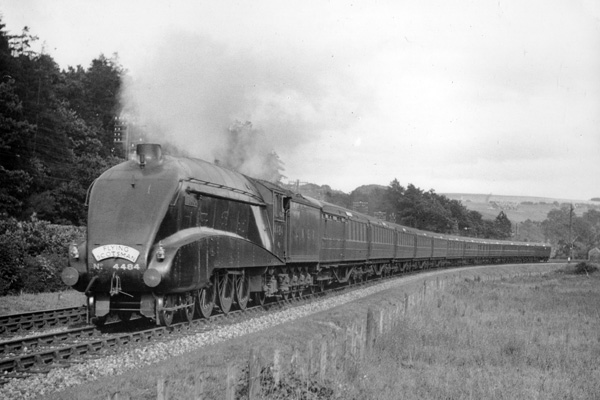
The year is 1937, when A4s took over the "Flying Scotsman" and No 4484, Falcon is at Grantshouse with the Down train. Recently introduced end-vestibule carriages are at the head and behind them, clearly visible is the Toilet 3rd and a 1928 RTS. On this occasion, 12 coaches altogether. Photo: E.R. Wethersett, author's collection.
Click on the image for an enlargement
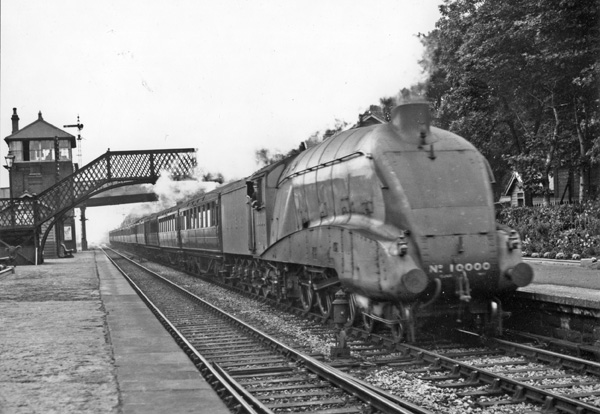
In a scene at Low Fell c1937-38, reboilered 4-6-4 W1 No 10000 passes through with a heavy express. Several strengtheners appear to have been placed behind the tender, beyond which the main train is carrying destination boards on the roof, including an RTS (it's not quite possible to tell if it's a 1924 or '28 design). Photo: LGRP, author's collection.
Click on the image for an enlargement
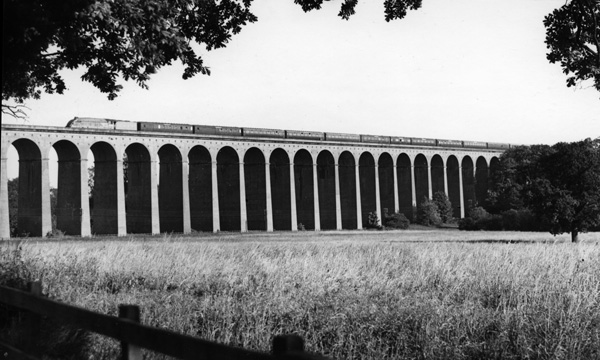
This well-known picture taken by E.R. Wethersett has suffered over the years from inaccurate captioning and a small mystery. The date was Thursday 8th June 1939 and the location, Digswell Viaduct (often miscaptioned as "Welwyn" viaduct). The train was not the
"10am Flying Scotsman with the 1938 [pressure ventilated] stock on a cloudy day"
but the 5.45pm King's Cross-Newcastle on a blazing summer's day with a mixture of normal carriages, including a 1924 RTS facing TO-RK-FO in traditional manner at the London buffers end.
Behind the FO was the 1st class accommodation (FK,CK) followed by the BG. Beyond, and only partly visible, were two through carriages for Hull (CK,BCK). There should have been another BCK there from Sunderland but it had been marshalled behind the tender instead. Between it and the RTS was the 3rd class part of the train (BTK, TK, TK, TK).
This was an East Coast express and the main formation was supplied with carriages from the ECJS fleet - except for the pair on the rear to Hull which were provided by the GN Section. For a long time, Hull was served like this, by portions detached from expresses at Doncaster. So, quite an interesting train, all told.
The mystery I mentioned at the outset concerns the A4 because Wethersett did not record the number and it's usually been captioned as "unidentified". I was curious and by extreme magnification and adjustment via Photoshop, I am convinced that it was No 4463 Sparrowhawk, which was a Gateshead loco which would have brought the train up to London in the morning (as the 8.15am from Newcastle) and was now heading home. Photo: E.R. Wethersett.
Further info:
It can make you weep to see the work of an expert like Wethersett wasted by a bogus caption and the scene he captured here speaks volumes. The main thing is that it shows how the LNER served the business traffic between two of the UK's prime manufacturing areas - the North East and the Capital. The principal express from Newcastle in the morning had been the 8am which contained two 1st class carriages (see illustration on p.11, Vol.1). The 10am "Silver Jubilee" was built to tap the same traffic and after its introduction, the 8am was retimed to leave at 8.15am with one less 1st class carriage but it was still an important and heavy train which picked up a through carriage from Sunderland (at York) and two from Lincoln (at Peterborough). A 1924 RTS had been provided from around 1928 when new construction allowed the earlier sets used in the "Flying Scotsman" services to be cascaded. Michael Harris wrote (1998) that take-up of catering in the Newcastle-KX service was second only the "Scotsman".
By the mid- to late-1930s the train was also being provided with newly-built end-vestibule carriages - the type designed for fast, long-distance expresses on the ECML. A BG was a fixed part of the formation, not so much for passengers' luggage but businessmen's paraphernalia - and parcels for same-day delivery from Newcastle to London. This BG seen here was also a recently built example with steel panelling and placed at the London buffers end.
Haulage in both directions was now by blue A4s allocated to Gateshead. In short, this was a crack express only one notch below the streamliners.
In the morning the two expresses arrived at King's Cross 45 minutes apart and they set off back to Newcastle behind their A4s even closer together, 15 minutes apart. At Digswell Viaduct the "Silver Jubilee" would have only just passed before Wethersett captured its partner.
Click on the image for an enlargement
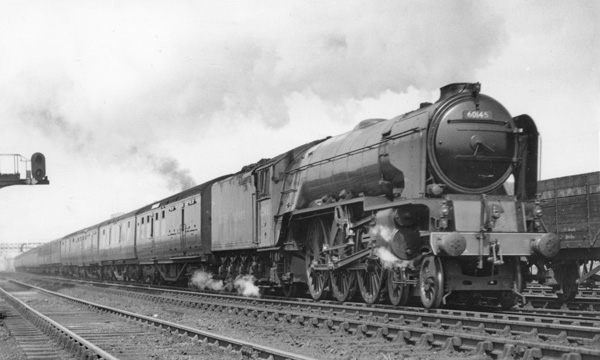
In April 1949, recently built Peppercorn A1 No 60145, in LNER apple-green and BRITISH RAILWAYS on the tender but not yet named Saint Mungo, is passing Geneva Road at Darlington with an express made up with Thompson carriages, but Gresley catering in the shape of a 1924 or '28 design RTS. Photo: Photomatic.
Click on the image for an enlargement
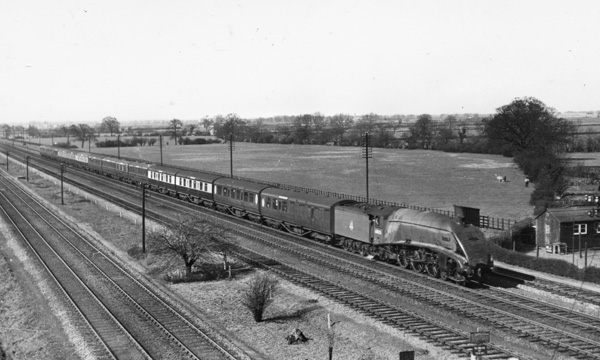
A4 No 60025 Falcon has an Up express at Helpston. All the identifiable carriages are Thompsons, some in painted teak livery, others in the experimental LNWR style colours. In the middle is a 1924 RTS. Photo: Author's collection.
Click on the image for an enlargement
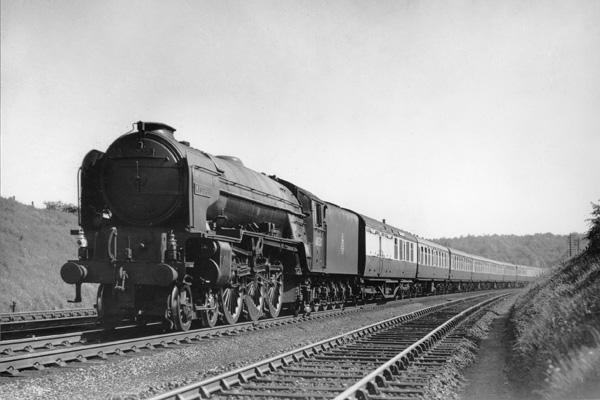
Peppercorn A1 No 60130 Kestrel is at Woolmers Green in May 1952 with the 3.30pm KX-Newcastle. The train has been modernised extensively and behind the leading Thompson 3rd brake there's a long string of BR Mk.1s with compartments and, just coming round the curve, a Gresley 1924 RTS, the only teak-panelled stock that can be seen. Photo: E.R. Wethersett.
Click on the image for an enlargement
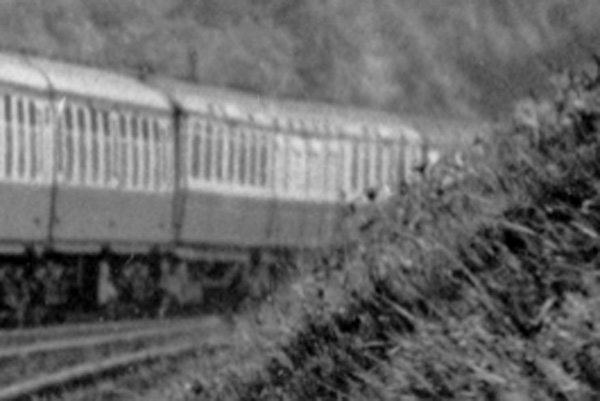
An enlargement showing the 1924 Gresley RTS with recessed end vestibule in fine condition, the 3rd class leading in the Down direction in the usual way.
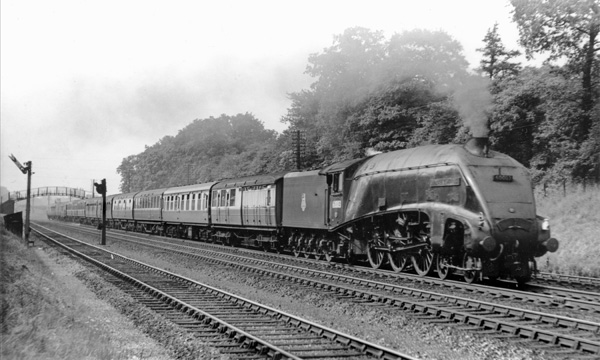
A Saturday in 1953 sees A4 No 60003 Andrew K. McCosh with an Up express near Wymondley. The formation is a mixture of Gresley and Thompson carriages with a single BR Mk.1, a CK, with the only visible destination board. Leading is a Gresley 52'6" BTK and the restaurant triplet set is a long way back. It looks like a 1924 one. The general appearance of the 13-coach formation is of a summer Saturday train, from Edinburgh or Newcastle.
The reversed headboard is of the kind carried by the "Yorkshire Pullman" or "Tees-Tyne Pullman", almost certainly the latter. Photo: G.W. Goslin.
Click on the image for an enlargement
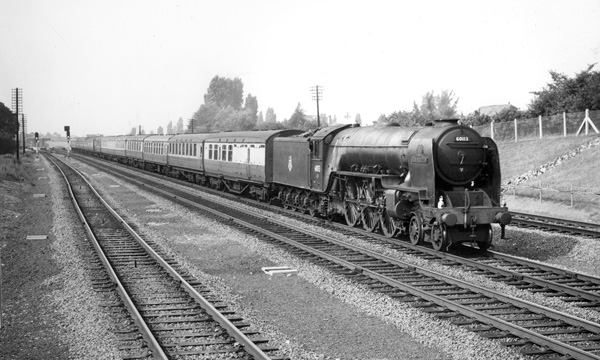
Another 1924-built RTS can be seen in this picture from 1955 which shows A1 No 60113 Great Northern passing Potters Bar with an up Fred Olsen Line special. With 14 carriages this was quite a heavy train and an RTS had been provided. Photo: E.R. Wethersett.
Click on the image for an enlargement
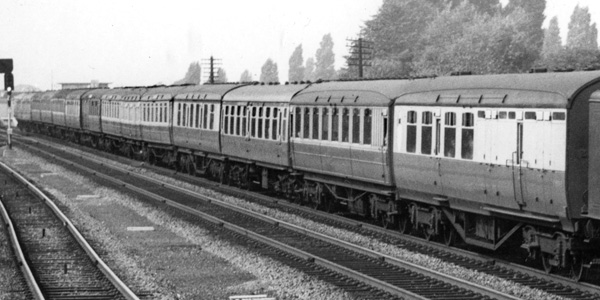
An enlargement shows the ad-hoc nature of this "made-up" formation with a mixture of Gresley teak, Thompson steel-panelled and BR Mk.1 all-steel coaches. Second behind the tender is a spare D.27 TO (dining). Four of the 14 carriages are carrying destination boards. Photo: E.R. Wethersett.
Click on the image for an enlargement
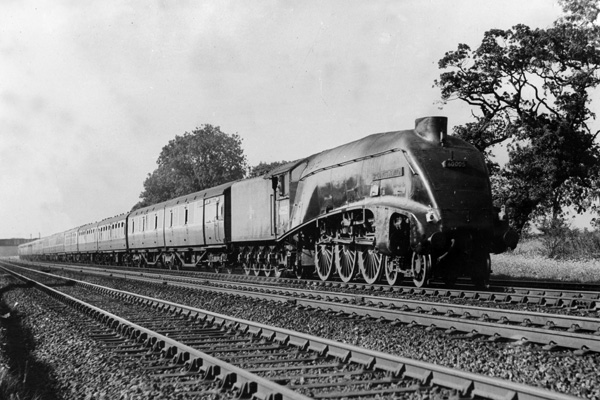
Sometime in the late 1950s, A4 No 60005 Sir Charles Newton has a heavy, 16-coach express, which may be a relief or an excursion, judging by the steel-panelled twin behind the tender (originally BTK-TK). Three BR Mk.1s follow and behind them, a Gresley teak-panelled RTS, either 1924 or '28-design. Photo: C. Ord Collection.
Click on the image for an enlargement
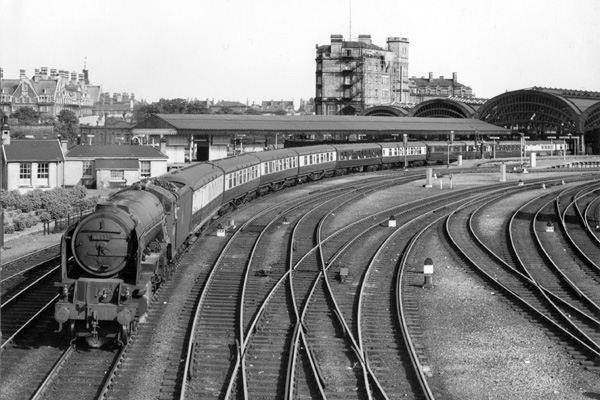
This picture has defied quite a lot of analysis! Leaving York with a Down express is A2 60533 Happy Knight. Gateshead A2s are known to have taken over the Down "Junior Scotsman" in September 1956 and that may be the train here in the following year, but other carriages don't tally with the roster, so no definitive statement from me on this one.
As with many other trains from this period, most of the carriages have been modernised but Gresley teak-panelled catering remains.
The stock at this end is Gresley (1), Thompson (3), BR Mk.1 (2) and, recently out-shopped in maroon livery, a 1924 RTS with the recessed end vestibules clear to see. The formation is the usual (TO-RK-FO) with the higher class at the London buffers end and, through the windows of the 1st class dining car, the table lamps can be seen. If only more train pictures had been taken like this - on a curve with oblique lighting! Photo: E. Treacy.
Click on the image for an enlargement
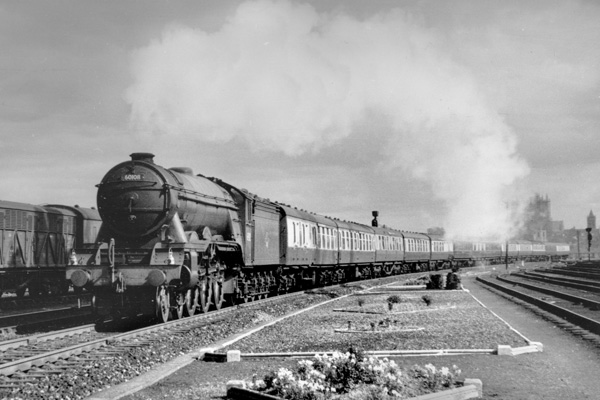
A3 No 60108 Gay Crusader (34A) leaves York in September 1957 with a KX-Tyne Commission Quay express. The body of the train, 13 coaches long, is a 50:50 mixture of Thompson and BR Mk.1 coaches, all bar one still in carmine & cream livery. Just one has received the newly introduced maroon. So has the 1928 restaurant triplet set in the middle of the train - the only remaining Gresley teak-panelled carriages in the formation. Behind the exhaust it's possible to see fresh grey roofs on the repainted coaches, quite pale under the late summer sun. Photo: Gavin Morrison.
Click on the image for an enlargement
2 - The Silver Jubilee
When the "Silver Jubilee" was introduced in 1935, catering in the new train was pretty conventional via an articulated triplet, albeit a one-off in its styling and, because the train ran out and back daily, only one was required. A significant difference, however, lay in the dimensions and the layout: the dining cars were an inch longer but the kitchen car was increased by almost six feet, from 41' to 45'11". Nearly five feet of that extra space was added to the kitchen.
As for the pantries, only one was provided. It was quite long, but there was only the one set of facilities for preparing food (these arrangements were to be revisited a few years later when, in 1938, the RTS for the all-new "Flying Scotsman" was designed.
The Diagrams previously showed articulated vehicles separately, here they were shown together, which made for a drawing about three feet wide!
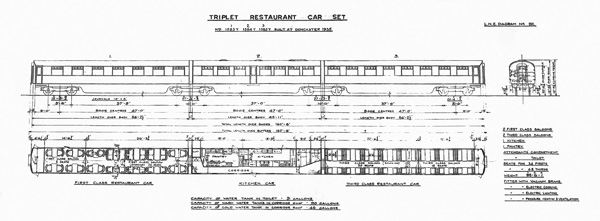
The whole drawing, D.201. In the book we described how the layout was modified and this shows that condition, not as originally built. Note the LNER jargon here, the two dining cars being described as "Restaurant Cars". Author's collection.
Click on the image for an enlargement
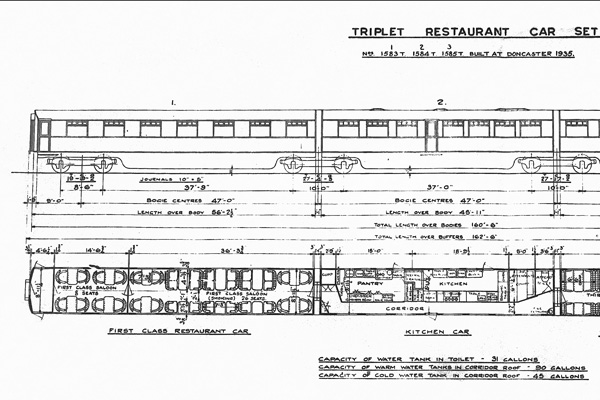
The left hand side, with modified 1st class dining car. Author's collection.
Click on the image for an enlargement
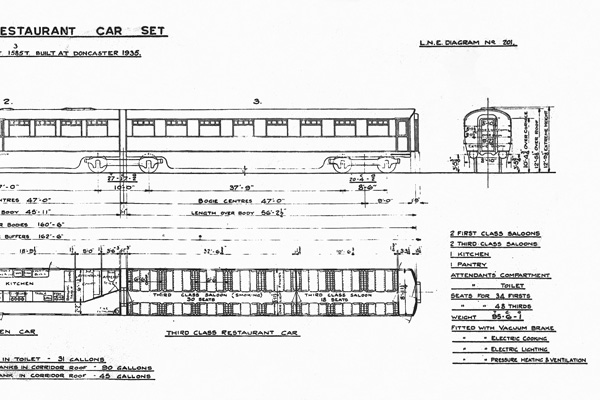
The right hand side. Author's collection.
Click on the image for an enlargement
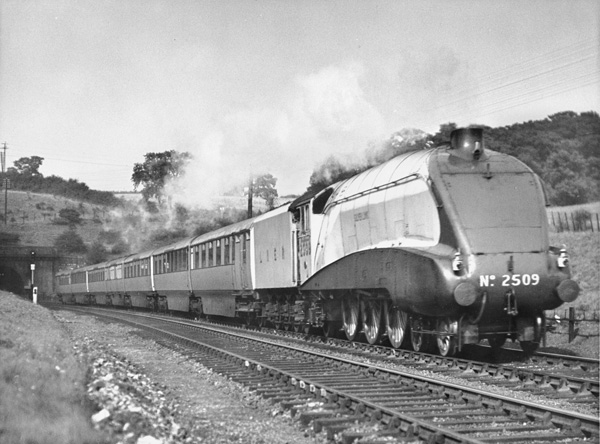
A4 No 2509 Silver Link streaks towards King's Cross at Hadley Wood. The curvature of the line allows the triplet in the middle to be seen fairly well, flanked by the twins (as originally built). The loco is in its second condition with modified handrail, front, and number over the buffers: date is probably summer 1936. Photo: author's collection.
Click on the image for an enlargement
After withdrawal of the "Silver Jubilee" in WWII, the body of the stock was used in Scotland while the RTS was used on the ECML.
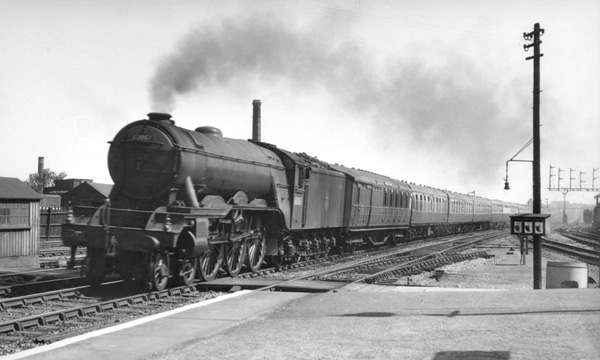
A3 No 60067 Ladas forges through Wood Green station on the fast line with the 3.30pm KX-Newcastle in July 1952. Most of the carriages were BR Mk.1 with a substitute Gresley BTK at the head, still in varnished teak livery and looking pretty dingy. In the middle of the train, the former "Silver Jubilee" triplet is resplendent in its carmine & cream livery. Photo: B.K.B. Green.
Click on the image for an enlargement
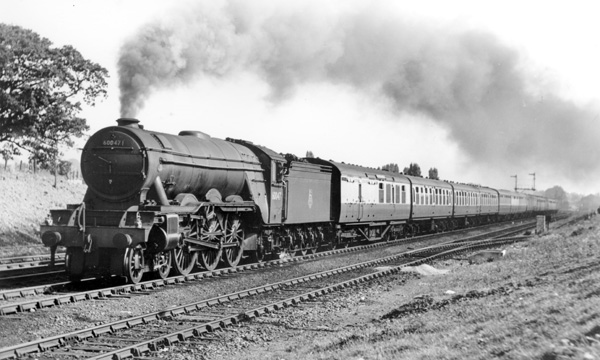
Sometime the following year, A3 No 60047 Donovan has the 5.35pm KX-Newcastle at Potters Bar. The formation is similar to the previous picture with mainly BR Mk.1s, but a Thompson BTK at the head. The former "Silver Jubilee" triplet still looks in marvellous condition and sits comfortably among the newer, steel-panelled and all-steel stock. Photo: G.W. Goslin.
Click on the image for an enlargement
3 - The 1938 Flying Scotsman
When the train was modernised in 1938 with all-new carriages, on steel angle trussing (see separate topic, link below), two restaurant triplet sets were supplied, one for each train.
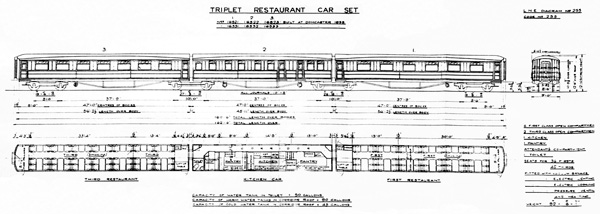
As with the "Silver Jubilee" triplet, the Diagram for the 1938 "Flying Scotsman" (D.255) was also drawn on a single page and a small part of the kitchen car on my copy has faded away.
The external lengths of the kitchen and dining cars copied the those in the "Silver Jubilee" but the layout of the kitchen car was changed again, in fact it reverted to the 1924 and 1928 triplets by having two pantries. The kitchen in between was made more compact while each pantry was fitted with its own double sinks. A need had been recognised to place greater emphasis on the preparation of food before cooking it.
This was the ultimate design and the best-equipped one. Compared with the original of 1924, the space given to the preparation and cooking of food had been increased by almost five feet, most of it in the so-called pantries, and with better facilities.
Stand-alone kitchen cars of even greater capacity were to be introduced by Thompson, indeed, the LNER had operated several all along, from the former "Flying Scotsman" one of 1914 to conversions for use with excursions, but that is a separate story.
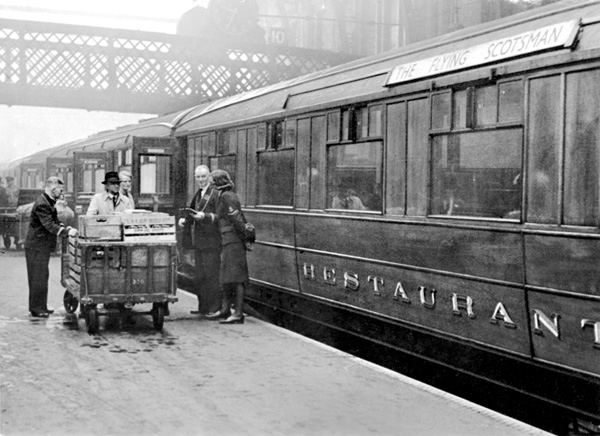
Taken on a murky day sometime in 1945 by Topical, preparations are afoot half an hour before the first departure since WWII with the catering in use again. The RK is just beyond the fresh food being loaded and Henry Wylie is standing outside the FO taking bookings for the first sitting, which will be at 11.30am.
The branding "Restaurant Car", as on other pictures of LNER restaurant cars, is clearly visible and supporting the criticism of the excessive size of the transfers for modellers - it was always visibly too large and a squeeze to fit. I'm told that Fox Transfers have just addressed this one - hooray!) :) Photo: author's collection.
Click on the image for an enlargement
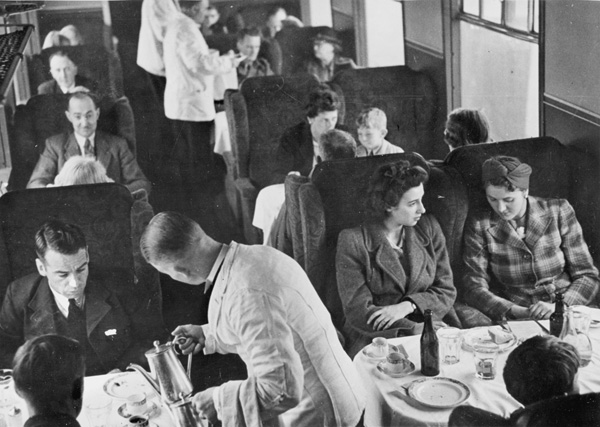
An action shot inside the 3rd Class dining car by Topical who captioned it "Coffee Sir?". Note the white jackets now being worn by the staff. Photo: author's collection.
Click on the image for an enlargement
In service
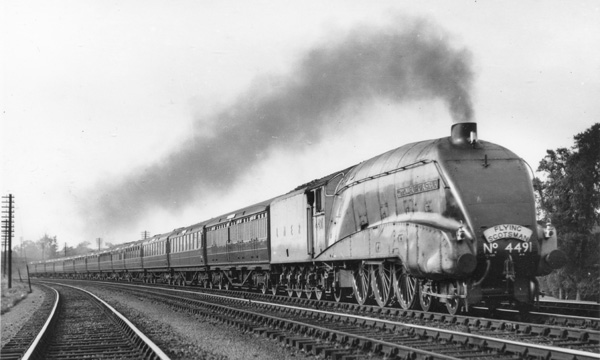
A grand view of the new train behind blue A4 No 4491 Commonwealth of Australia at Brookman's Park, probably in 1938. The restaurant triplet is clearly visible behind what looks like a stand-in 1st on turnbuckle trussing. Photo: Photomatic.
Click on the image for an enlargement
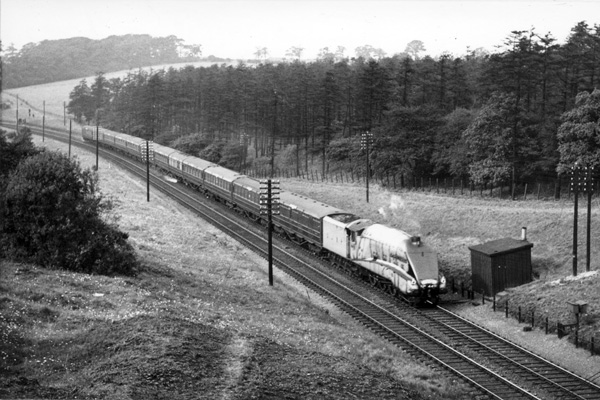
The year is 1938 and A4 No 4491 Commonwealth of Australia is passing Ganwick with the 1938-design "Flying Scotsman". The (mostly) pressure-ventilated stock is evident and the dedicated RTS on steel-angle trussing. The unique buffet lounge is alas hidden by a telegraph pole. Photo: E.R. Wethersett.
Click on the image for an enlargement
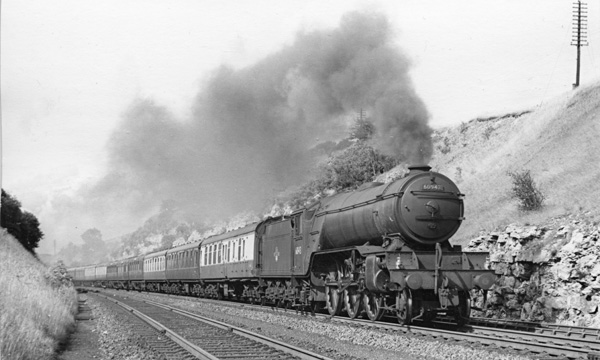
The "Northumbrian" is captured at Great Ponton in July 1958 behind a stand-in V2, No 60943. All the visible carriages are BR Mk.1s, except for a recently refurbished RTS from the 1938 "Flying Scotsman". Photo: P.H. Groom.
Click on the image for an enlargement
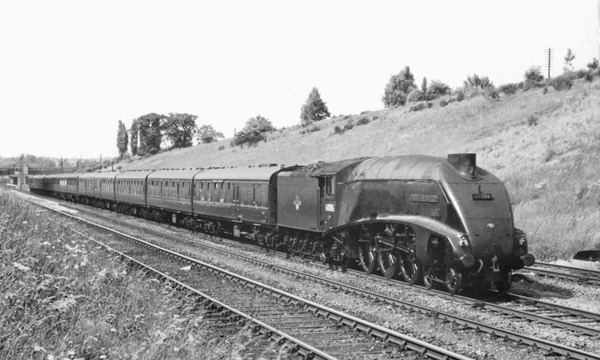
The following year an RTS from the ex-1938 "Flying Scotsman" is seen in the Up 9.55am Newcastle-KX at Oakleigh Park behind A4 No 60006 Sir Ralph Wedgewood. Once again, the triplet is surrounded by BR Mk.1 coaches and the whole train is now in BR maroon livery. June 1959. Photo: David Percival.
Click on the image for an enlargement

